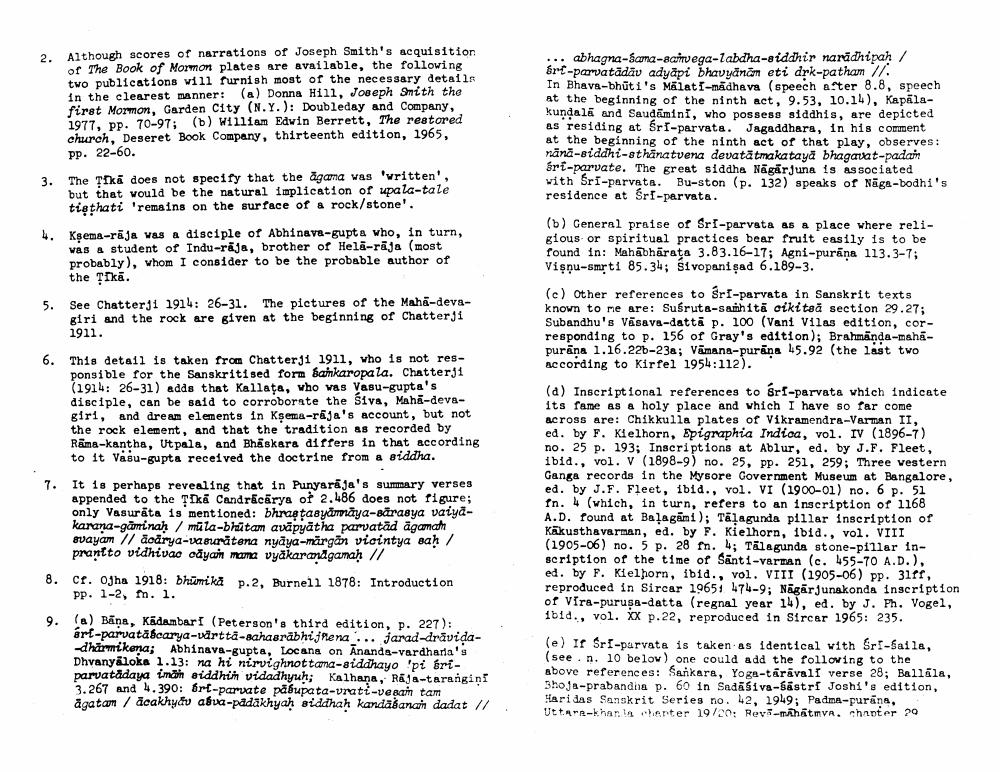Book Title: Interpreting Vakyapadiya 2486 Historically Author(s): Ashok Aklujkar Publisher: Ashok Aklujkar View full book textPage 4
________________ 2. Although scores of narrations of Joseph Smith's acquisition of The Book of Mormon plates are available, the following two publications will furnish most of the necessary details in the clearest manner: (a) Donna Hill, Joseph Smith the first Mormon, Garden City (N.Y.): Doubleday and Company, 1977, pp. 70-97; (b) William Edwin Berrett, The restored church, Deseret Book Company, thirteenth edition, 1965, pp. 22-60. ... abhagna-Sama-samvega-labdha-siddhir naridhipah / &rt-pamatādāv adyapi bhavyanam eti drk-patham //. In Bhavs-bhūti's Malati-madhava (speech a ter 8.8, speech at the beginning of the ninth act, 9.53, 10.14), Kapalakundala and Saudimint, who possess siddhis, are depicted as residing at Sri-parvata. Jagaddhars, in his comment at the beginning of the ninth act of that play, observes: näna-siddhi-sthanatvena devatătmakatayd bhaganat-padan brf-parvate. The great siddha Nāgarjuna is associated vith SrI-parvata. Bu-ston (p. 132) speaks of Nage-bodhi's residence at Sri-parvata. The Tikā does not specify that the agama was 'written', but that would be the natural implication of upala-tale tiethati 'remains on the surface of a rock/stone'. Ksema-raja Vas a disciple of Abhinava-gupta who, in turn, was a student of Indu-rāja, brother of Hela-rija (most probably), whom I consider to be the probable author of the Tikā. 5. See Chatterji 1914: 26-31. The pictures of the Maha-deve giri and the rock are given at the beginning of Chatterji 1911. 6. This detail is taken from Chatterji 1911, who is not responsible for the Sanskritised form bankaropala. Chatterji (1914: 26-31 ) adds that Kallaţa, who was Vasu-gupta's disciple, can be said to corroborate the Siva, Maha-devegiri, and dream elements in Ksema-raja's account, but not the rock element, and that the tradition as recorded by Rama-kantha, Utpala, and Bhaskara differs in that according to it Vagu-gupta received the doctrine from a siddha. (b) General praise of Sri-parvata as a place where religious or spiritual practices bear fruit easily is to be found in: Mahabharata 3.83.16-17; Agni-purāņa 113.3-7; Vişnu-smrti 85.34; Sivopanişad 6.189-3. (c) Other references to SrI-parvata in Sanskrit texts known to me are: Susruta-sanhita oikitoa section 29.27; Subandhu's Vasava-datta p. 100 (Vani Vilas edition, corresponding to p. 156 of Gray's edition); Brahmanda-mahipurana 1.16.220-238; Vānana-purana 45.92 (the last two According to Kirfel 1954:112). (a) Inscriptional references to Sri-parvata which indicate 1ts fame as a holy place and which I have so far come across are: Chikkulla plates of Vikramendra-Vartan II, ed. by F. Kielhorn, Epigraphia Indioa, vol. IV (1896-7) no. 25 p. 193; Inscriptions at Ablur, ed. by J.F. Fleet, ibid., vol. V (1898-9) no. 25, pp. 251, 259: Three western Ganga records in the Mysore Government Museum at Bangalore, ed. by J.F. Fleet, ibid., vol. VI (1900-01) no. 6 p. 51 in. 4 (which, in turn, refers to an inscription of 1168 A.D. found at Balagāni); Talagunda pillar inscription of Kakusthavarman, ed. by F. Kielhorn, ibid., vol. VIII (1905-06) no. 5 p. 28 in. 4; Tālagunds stone-pillar inscription of the time of Santi-varman (c. 455-70 A.D.), ed. by F. Kielhorn, ibid., vol. VIII (1905-06) pp. 317f, reproduced in Sircar 19651 474-9; Nagarjunakonda Inscription of Vira-purusa-datta (regnal year 14), ed. by J. Ph. Vogel, 101d., vol. XX p. 22, reproduced in Sircar 1965: 235. (e) If SrI-parvata is taken as identical with Sri-faila, (see. n. 10 below) one could add the following to the above references: Sankara, Yoga-tárávalt verse 28; Ballila, 3hoje-prabandha p. 60 in Sadasiva-Sastri Joshi's edition, Haridas Sanskrit Series no. 42, 1949; Padma-purans, Uttarkhante hanter 19/20: Revhätma. chapter 29 It is perhaps revealing that in Punyaraja's summary verses appended to the TD Candrācārys of 2.486 does not figure; only Vasurata is mentioned: bhratasydmaya-adrasya valydkarana-gaminah / mula-bhitam awapyatha parvatad agamath evayam // dodrya-ramaritena nyaya-mărgă vicintya sah prantto vidhivao odyan mama vyakarondgamah Il cf. Ojha 1918: bhumika p.2, Burnell 1878: Introduction PP. 1-2, m. 1. (8) Bana, Kadambar! (Peterson's third edition, p. 227): ort-parvatabcarya-urtta-sahasrabhijhena ... jarad-dravida dharmikena; Abhinava-gupta, Locans on Ananda-vardhara's Dhvanyaloka 1.13: na hi nirvighnottama-siddhayo 'pi eriparvatadaya iman aiddhi vidadhyuh; Kalhana, Raja-tarangini 3.267 and 4.390: Orf-parute påbupata-unti-vegain tam agatan / deakhyu abua-padakhyah siddhah kandasanah dadat //Page Navigation
1 2 3 4 5 6
